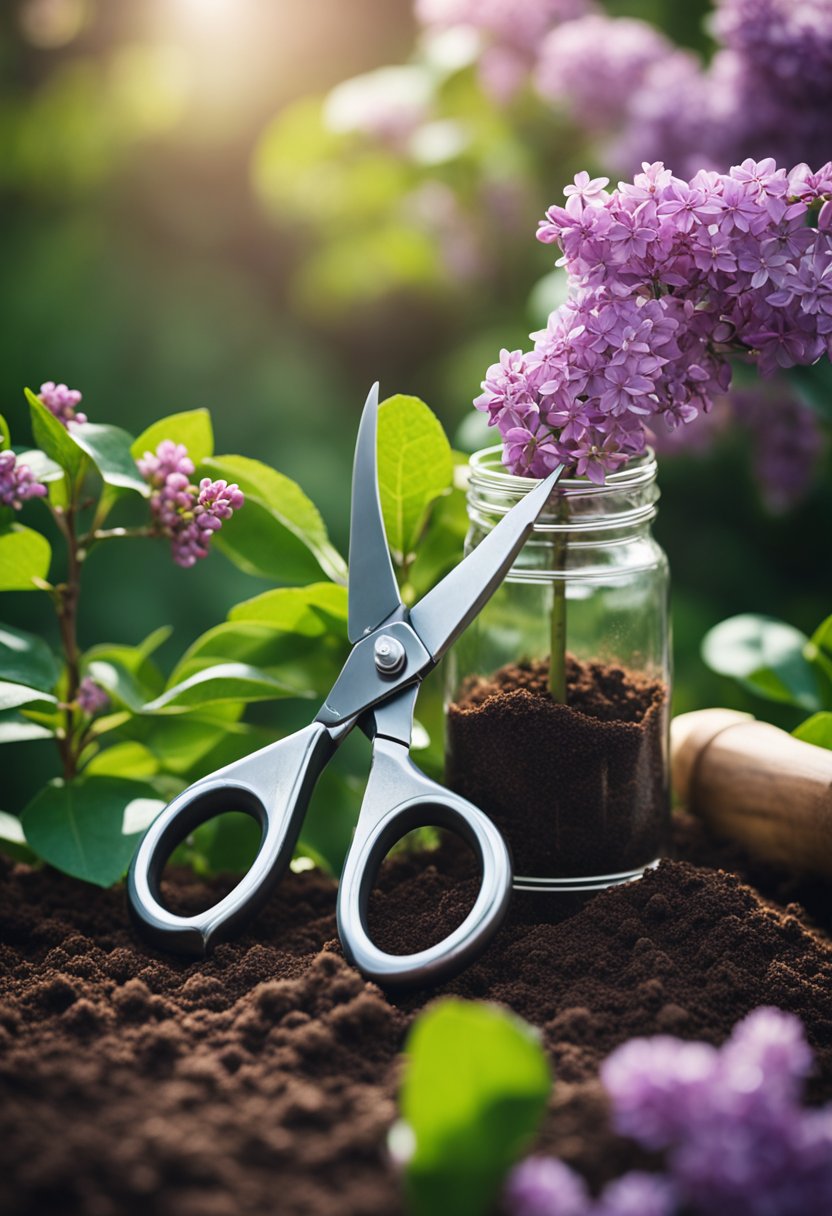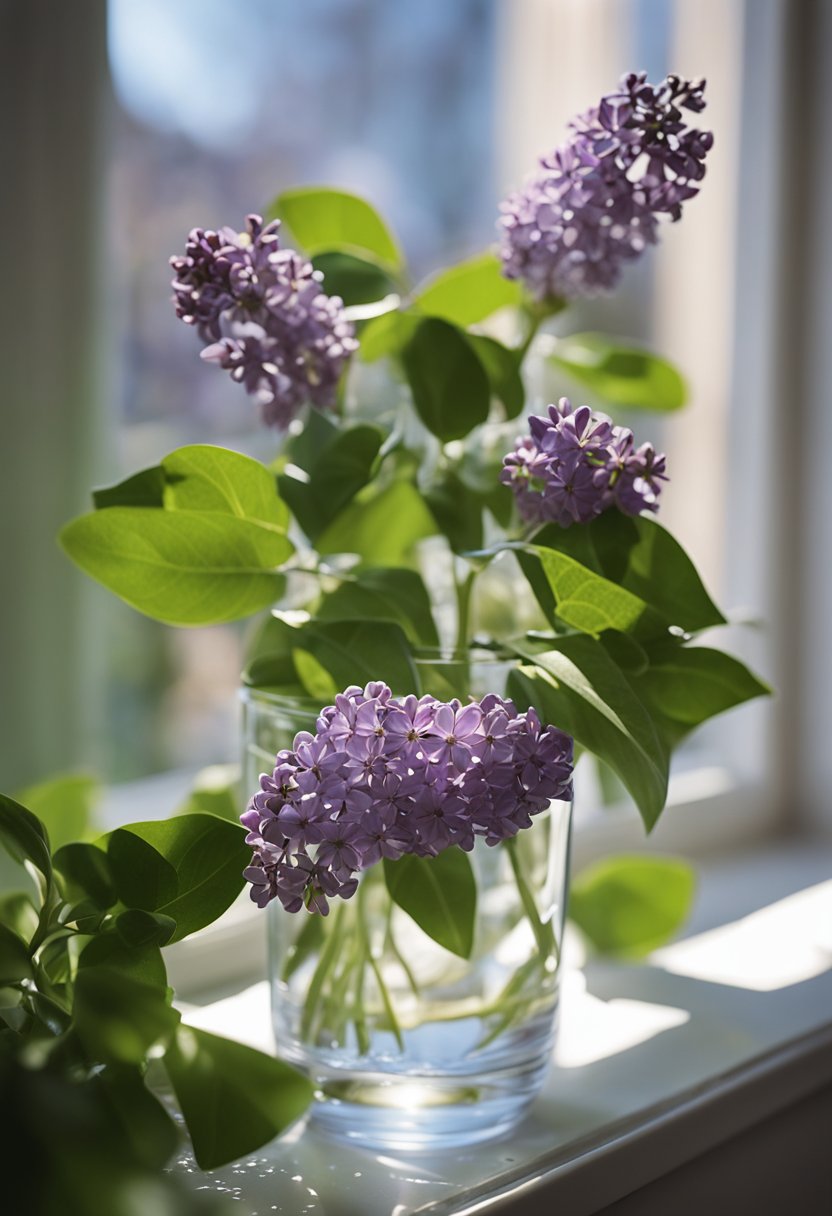If you’re a fan of lilacs, you know that their beauty and fragrance are unmatched. While it’s easy to purchase lilac bushes from a nursery, propagating them from cuttings is a cost-effective and rewarding way to grow your own lilac garden.
This post may contain affiliate links.
In this article, we’ll show you how to grow lilacs from cuttings, so you can enjoy their beauty and fragrance without breaking the bank.
First, it’s important to understand that not all lilacs are suitable for propagation from cuttings. Common lilacs, also known as Syringa vulgaris, are the most commonly propagated variety and the easiest to grow.
However, other varieties, such as tree lilacs or Japanese lilacs, may not root as easily or at all. It’s important to choose healthy, disease-free cuttings from a mature lilac bush to ensure the best chance of success.
Related Article: Tips for Growing Lilacs: A Guide to Cultivating Beautiful Blooms

Choosing the Right Cuttings
If you want to grow lilacs from cuttings, it’s important to choose the right ones. Here are some tips to help you identify healthy lilac shoots and determine the best time for taking cuttings.
Identifying Healthy Lilac Shoots
When selecting a lilac cutting, look for healthy, green stems that are about 4-6 inches long. The stem should be straight and not too thin or too thick. Avoid stems that are diseased, damaged, or have any signs of pests.
Related Article: Are Lilacs Edible? Discover the Answer Here
It’s also important to choose a stem that has at least two pairs of leaves. The leaves should be healthy, green, and free from any damage or disease.

Best Time for Taking Cuttings
The best time to take lilac cuttings is in early summer, when the stems are still green and flexible. Softwood cuttings taken at this time have a higher chance of success than those taken later in the season.
To take a cutting, use a sharp, clean pair of pruning shears to cut the stem at a 45-degree angle just below a node (where a leaf meets the stem). Remove any leaves from the bottom half of the stem, leaving only the top two pairs of leaves.
Once you have chosen your cuttings, it’s important to plant them as soon as possible to prevent them from drying out. With the right care and attention, your lilac cuttings should root and grow into healthy, beautiful plants.
Related Article: When Do Lilacs Bloom?
Preparing for Propagation
Propagating lilacs from cuttings can be a rewarding experience for any gardener. Before you begin, it’s important to prepare a suitable environment and gather the necessary supplies.
Creating a Suitable Environment
To successfully propagate lilacs, you’ll need to create a suitable environment for the cuttings to grow in. This means providing the right amount of moisture, light, and warmth. Here are some tips to help you create the perfect environment:
- Choose a location that gets plenty of indirect sunlight.
- Use a well-draining soil mix that’s rich in nutrients. A mix of perlite and potting soil is ideal.
- Keep the soil moist, but not waterlogged. Overwatering can cause the cuttings to rot.
- Use a humidity dome or plastic bag to help retain moisture and create a humid environment. This will help the cuttings to root faster.
Gathering Necessary Supplies
To propagate lilacs from cuttings, you’ll need a few supplies. Here’s a list of what you’ll need:
- Pruning shears or a sharp knife to take the cuttings.
- Rooting hormone to help the cuttings root faster.
- A container filled with a well-draining soil mix.
- A humidity dome or plastic bag to create a humid environment.
- Labels to keep track of the different varieties of lilacs you’re propagating.
By preparing a suitable environment and gathering the necessary supplies, you’ll be well on your way to successfully propagating lilacs from cuttings. With a little patience and care, you’ll soon have a beautiful collection of lilac bushes to enjoy in your garden.
Related Article: Lilac Lemonade
Planting the Cuttings
Once your lilac cuttings have rooted, it’s time to plant them in soil. Here’s what you need to know:
Rooting Techniques
There are a few different techniques you can use to root your lilac cuttings. One popular method is to dip the cut end of the stem in rooting hormone and then plant it in a mixture of potting soil and sand. Another option is to place the cutting in a jar of water until roots begin to form, and then transfer it to soil.
No matter which method you choose, it’s important to make sure your cuttings have at least one node (the spot where a leaf grows from the stem) and several leaf nodes on the stem. This will help ensure that the cutting can grow into a healthy plant.
Optimal Soil and Containers
When planting your lilac cuttings, it’s important to use a well-draining potting soil that’s rich in nutrients. You can mix in some sand or peat moss to improve drainage if needed.
Choose a container that’s just slightly larger than the cutting, and make sure it has drainage holes in the bottom. This will help prevent water from pooling and causing root rot.
Once you’ve filled the container with soil, make a small hole in the center and gently place the cutting in it. Press the soil firmly around the stem to ensure good contact, but be careful not to damage the delicate roots.
With proper care and attention, your lilac cuttings should grow into healthy, thriving plants that will bring beauty and fragrance to your garden for years to come.
Caring for Lilac Cuttings
Learning how to grow lilacs from cuttings can be a rewarding experience, but it requires proper care and attention to ensure the cuttings thrive and develop into healthy plants. Here are some tips on how to care for your lilac cuttings:
Watering and Humidity Control
Watering is crucial for the survival of your lilac cuttings. Make sure to keep the soil moist but not waterlogged. You can mist the cuttings with water to keep the humidity level high, which will help the cuttings retain moisture and promote new growth.
To prevent the cuttings from drying out, cover them with a plastic bag or a clear plastic container. This will create a mini greenhouse that will keep the humidity level high and protect the cuttings from direct sunlight.
When to Transplant
Once your lilac cuttings have developed a root system and new growth, it’s time to transplant them into individual pots. This usually takes about 6-8 weeks. You can check the progress by gently tugging on the cuttings. If you feel resistance, it means the roots have started to develop.
When transplanting, make sure to use a well-draining soil mix and a pot that is slightly larger than the root ball. Water the soil thoroughly after transplanting to help settle the soil around the roots.
In conclusion, taking care of your lilac cuttings involves providing them with adequate water and humidity, as well as knowing when to transplant them into individual pots. With proper care, your lilac cuttings will develop into healthy plants that will bring beauty and fragrance to your garden.
Ensuring Successful Growth
Growing lilacs from cuttings can be a rewarding experience, but it requires careful attention to detail to ensure success. Here are some tips to help you ensure that your lilac cuttings grow strong and healthy:
Monitoring and Adjusting Conditions
To ensure that your lilac cuttings thrive, it’s important to monitor and adjust their growing conditions as needed. Here are some factors to keep in mind:
- Full sun: Lilacs need plenty of sunlight to bloom, so make sure your cuttings are getting at least six hours of direct sunlight each day.
- Moisture: Lilacs prefer well-drained soil that is kept consistently moist. Check the soil regularly and water as needed to keep it evenly moist.
- Temperature: Lilacs prefer cooler temperatures, so if you live in a warm climate, you may need to provide some shade or extra watering to keep your cuttings from getting too hot.
- Fertilizer: Lilacs don’t need a lot of fertilizer, but a balanced, slow-release fertilizer can help promote healthy growth. Follow the instructions on the package carefully and don’t over-fertilize.
Dealing with Common Issues
Even with careful attention, lilac cuttings can sometimes run into problems. Here are some common issues and how to deal with them:
- Disease: Lilacs are susceptible to a number of diseases, including powdery mildew and verticillium wilt. To prevent disease, make sure your cuttings are planted in well-drained soil and avoid overhead watering. If you notice signs of disease, such as yellowing leaves or powdery growth, treat the plants with a fungicide.
- Pests: Lilacs can be attacked by a number of pests, including aphids and spider mites. To prevent pests, keep your cuttings clean and free of debris. If you notice signs of infestation, such as distorted leaves or webbing, treat the plants with an insecticide.
- No blooms: If your lilac cuttings aren’t blooming, it could be due to a number of factors, including insufficient sunlight, improper pruning, or lack of nutrients. Make sure your cuttings are getting enough sunlight and water, and fertilize as needed. Prune your plants in the fall or early spring to promote healthy growth and encourage blooming.
By following these tips and monitoring your lilac cuttings carefully, you can ensure that they grow strong and healthy, and bloom beautifully in your garden.
Frequently Asked Questions
What is the best time of year to take lilac cuttings for propagation?
The best time to take lilac cuttings is in the late spring or early summer when the plant is actively growing. You want to select a stem that is not too young or too old, and has a diameter of about 1/4 to 1/2 inch.
Can you root lilac cuttings in water, and if so, how should you do it?
Yes, you can root lilac cuttings in water. Simply take a cutting and remove the leaves from the bottom 2 inches of the stem. Place the stem in a jar of water, making sure the water covers the bottom 2 inches of the stem.
Change the water every few days and wait for roots to form before transplanting the cutting to soil.
What are the steps for planting lilac cuttings directly into soil?
To plant lilac cuttings directly into soil, select a well-draining location with partial shade. Prepare the soil by mixing in compost or other organic matter. Take a cutting and remove the leaves from the bottom 2 inches of the stem.
Dip the end of the stem in rooting hormone and plant it in the soil, making sure the soil is moist but not waterlogged. Cover the cutting with a plastic bag to create a humid environment and keep it in partial shade until roots form.
Is it possible to grow lilacs from cuttings indoors, and what conditions do they require?
Yes, it is possible to grow lilacs from cuttings indoors. To do so, you will need a pot with well-draining soil, a cutting, and a sunny location.
Follow the same steps as planting directly into soil, but keep the pot in a warm, sunny location and mist the cutting regularly to maintain humidity.
How do you use rooting hormone to increase the success rate of lilac cuttings?
To use rooting hormone, simply dip the end of the cutting in the hormone powder or gel before planting it in soil or water. The hormone will stimulate root growth and increase the success rate of the cutting.
Can you explain the method of rooting lilac cuttings using potatoes?
To root lilac cuttings using potatoes, select a potato that is large enough to hold the cutting. Cut a hole in the potato and insert the cutting, making sure it is secure.
Plant the potato in soil with the cutting sticking out of the top. The potato will provide moisture and nutrients to the cutting as it forms roots.
Follow my lilacs board on Pinterest.



